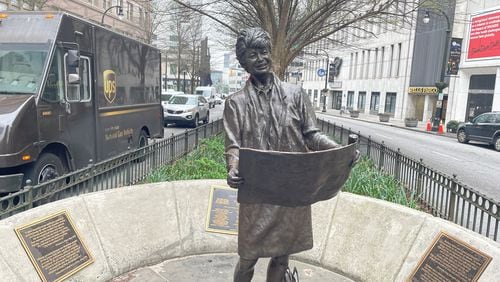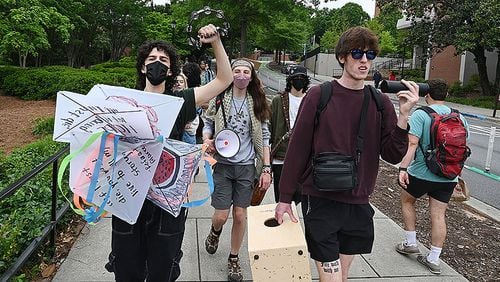It’s been a long time since I’ve been to downtown Atlanta when I meet Amy Durrell outside the William Oliver Building at the intersection of Peachtree and Marietta streets.
MARTA buses and delivery trucks zip by as Durrell, co-founder of History Afoot Atlanta, shares a 90-second history of Atlanta followed by an information-packed hour and a half in which she tells the stories of women as they navigated life in a growing metropolis at the start of the 20th century as well as the later decades.
Durrell began leading tours years ago for the Atlanta Preservation Center but quickly discovered something was missing. “I was a working woman in downtown Atlanta, and I was only talking about men. I began looking for women’s voices and they were hard to find,” she says.
While attending Georgia State University’s Masters of Heritage Preservation program with a focus on Public History, Durrell met Lisa Flaherty and they partnered to create History Afoot Atlanta.
It wasn’t until 1995 that the Georgia Historic Preservation Division of the Department of Natural Resources established the Georgia Women’s History Initiative to address the topic of women’s history in “the identification, documentation, evaluation, and preservation of historic places.”
The mission was to integrate women’s history and the preservation of historic places associated with women into the division’s regular activities.
It took 100 years after women had made a mark on the urban landscape for their imprint to become a priority for historic preservation.
“Women were idealized as wives and mothers,” says Durrell, noting the handful of statues of real women located in downtown Atlanta, “but they were also active agents in supporting their families.”
At the corner, we look toward the viaduct that was built over the railroad tracks in 1880. This would have been the city’s retail center, and Durrell asks me to imagine Whitehall Street bustling with commerce: Kuhns’ Photography Studio, where the Kuhns brothers took photographs while their sister retouched their photos and worked as a clerk, and Regenstein’s Wholesale and Retail Millinery, the first store in the South to hire a woman as a sales clerk.
This is also where Carrie Steele, who was enslaved in Macon before moving to Atlanta, worked as a cleaning lady for the railroad. In 1886, Steele acquired an empty railcar in which she educated and cared for abandoned Black children. She managed to raise $5,000 to build a three-story brick building that would become the nation’s first orphanage for Black children in 1892.
“We don’t know how she figured it out,” Durrell says, adding that there usually isn’t much information about the lives of early women or details of how they accomplished the things they did at a time when they faced many obstacles.
Standing on the greenway of Marietta Street, now known as Barbara Asher Square, we view the statue of the late Barbara Asher, beloved member of the Atlanta City Council elected in 1977. Unlike the renderings of other women, Asher, the statue, looks happy, striking a confident pose. Durrell points out that the inscription still emphasizes her role as a wife and mother.
As we walk, Durrell gives insight into the history of women writers and restaurant owners, politicians and parents. “I want to make sure I tell all kinds of stories,” she says. “We ground it in history and the historians we have read, but we bring our own interests and we also find out stories from people on the tour to connect it to their lives.”
Flaherty, who works for Delta, sometimes infuses her tours with stories about women’s roles in the company, Durrell tells me. Both women are constantly learning and adding new information to the tours.
Not far from Broad Street, I sit down to rest as Durrell shares the story of Birdie Owens. Owens was into the “sporting life” and hung out at dance halls in the 1910s doing animal dances. I am confused, but Durrell gamely breaks into the Turkey Trot, leaning forward and flapping her arms.
The city responded to women’s newly found freedom in the entertainment district by hiring police matrons, women who went to the movies or dance halls to police other women, Durrell says.
We end our tour at the Candler Building, completed in 1906 by Asa Candler, the founder of Coca-Cola Co. Candler was not running Coca-Cola at the time, but he had a lot of money and was interested in real estate, says Durrell.
He was an integral part of the design process and chose the 10 men whose images are carved on the building’s exterior. The only women featured were stylized figures on the exterior, and inside the building, which was converted to a boutique hotel in 2019, is a carving of Candler’s mother.
“He was a leader in the community, and he sent a message to us as to who was important,” says Durrell.
The groups attending the History Afoot Atlanta tours have been mostly women, according to Durrell, which makes me hope more men will invest $25 and an hour and a half of their time during Women’s History Month to pay tribute to the women who helped make the city of Atlanta what it is today.
Read more on the Real Life blog (www.ajc.com/opinion/real-life-blog/) and find Nedra on Facebook (www.facebook.com/AJCRealLifeColumn) and Twitter (@nrhoneajc) or email her at nedra.rhone@ajc.com.
About the Author







/cloudfront-us-east-1.images.arcpublishing.com/ajc/FTAF5ZMCDZD5ZJ5SZ2U3Z5O2VI.JPG)